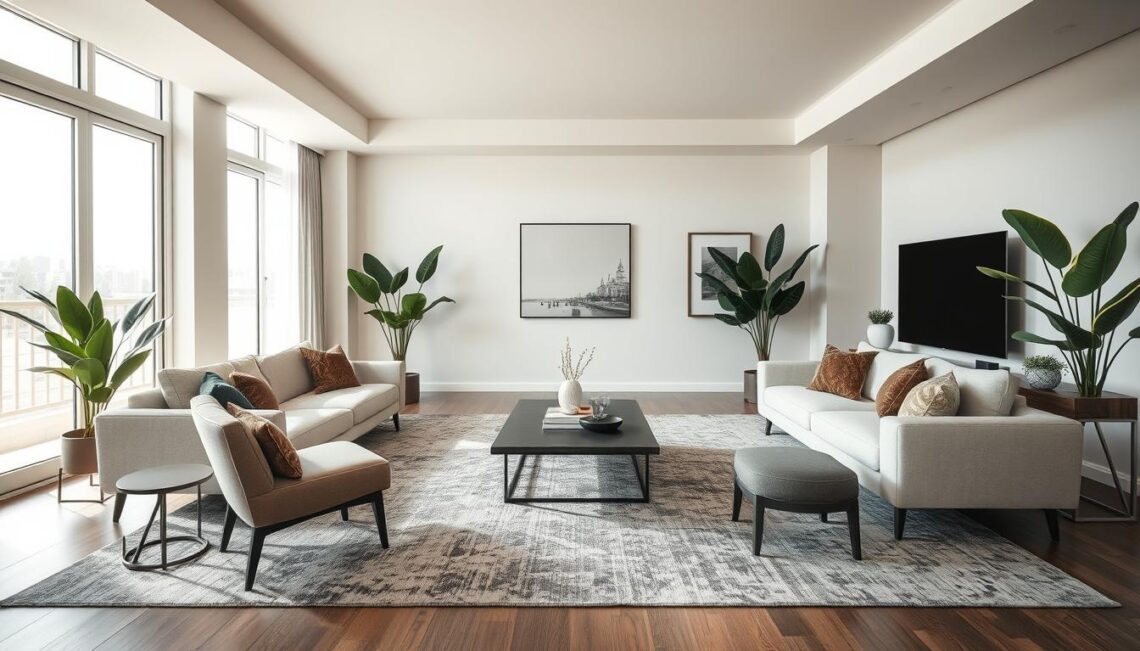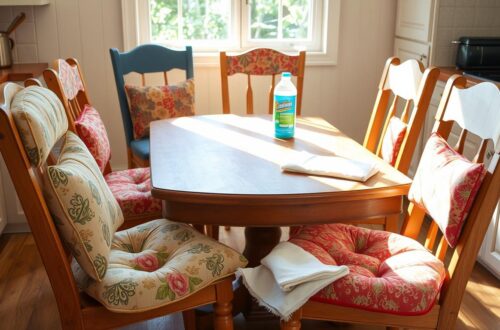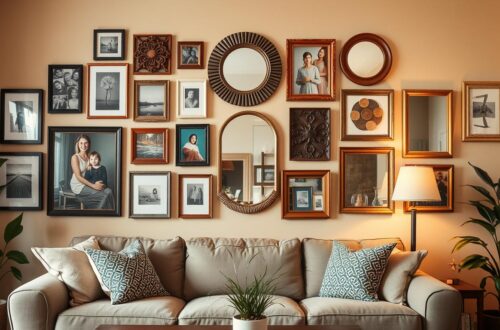Arranging furniture in a rectangular living room can be a challenging task, but with the right strategies, you can transform your space into a functional and visually appealing haven. Whether you’re dealing with obstacles like double entrance doors, French doors, fireplaces, or windows, or simply struggling to find the perfect layout for your large TV and family clutter, this guide will provide you with the tools to maximize the potential of your rectangular living room.
Rectangular living rooms can often feel long and narrow, creating a tunnel-like effect that can be difficult to navigate. However, with the right approach, you can create a cohesive and inviting space that caters to your family’s needs. By understanding the purpose of your living room and strategically positioning key furniture pieces, you can enhance the room’s proportions, improve traffic flow, and design a functional yet stylish area.
In this comprehensive guide, we’ll delve into the essential steps to arranging furniture in a rectangular living room for maximum space and optimal flow. From deciding on the room’s primary function to incorporating height and visual interest, we’ll cover a range of strategies to help you transform your living space into a true reflection of your style and lifestyle.
Key Takeaways
- Understand the purpose of your rectangular living room and create distinct functional zones to maximize space.
- Strategically position key furniture pieces, such as the sofa and focal point, to anchor the room and enhance its proportions.
- Utilize corners and walls to incorporate additional seating and define separate areas within the space.
- Incorporate rugs to visually separate zones and tie the furniture together for a cohesive look.
- Introduce height, color, and shape to the room to disrupt the long, narrow feel and create visual interest.
Understand the Room’s Purpose and Create Functional Zones
When arranging furniture in a rectangular living room, the first step is to understand the room’s primary function and how you want to utilize the space. Decide if the room is meant for relaxation, entertainment, work, or a combination of uses. This will guide you in dividing the space into distinct functional zones, such as a seating area, a reading nook, or a dedicated workspace.
Decide on the Room’s Primary Function
Determining the room’s primary purpose will help you make informed decisions about the furniture arrangement and layout. Consider how you and your family typically use the living room. Is it a space for casual gatherings, formal entertaining, or a combination of both? Understanding the room’s primary function will ensure that you create an efficient and practical design that meets your needs.
Divide the Space into Distinct Areas
Once you have identified the room’s primary function, divide the rectangular space into distinct zones to maximize its potential. For example, you could create a conversation area with comfortable seating, a reading nook with a cozy chair and a side table, and a multipurpose zone that can be used for work or entertainment. By defining these zones, you can ensure that the room is both visually appealing and highly functional.
Incorporating multi-functional furniture, such as a day bed with storage or a sectional sofa, can help you make the most of the available space in a rectangular living room. Additionally, strategically placing mirrors can create the illusion of a more spacious and bright environment.
| Benefits of Defining Functional Zones | Tips for Creating Distinct Areas |
|---|---|
|
|
“Defining functional zones in a rectangular living room not only enhances the practicality of the space but also adds visual interest and a sense of balance to the overall design.”
Strategically Position Key Furniture Pieces
When arranging furniture in a rectangular living room, strategic positioning of key pieces is crucial. Start by identifying a focal point, such as a fireplace, a large window, or a statement piece of artwork. Arrange the furniture around this focal point to anchor the room and create a visually appealing centerpiece.
Anchor the Room with a Focal Point
The focal point should be the central element that draws the eye and sets the tone for the entire space. Positioning the furniture to highlight this focal point will create a sense of balance and cohesion in the room. Symmetry can also impose a sense of order, as suggested by design expert Kritsada Panichgul.
Arrange Furniture Across the Width
Instead of lining up furniture along the long walls, consider placing pieces across the width of the room. This approach can help break up the linear appearance and make the space feel more balanced and inviting. According to designer Laurie Black, a diagonal arrangement of furniture can create dimension and a welcoming pathway.
For small living rooms, using chairs instead of sofas or love seats can create a sense of space, as suggested by Michael Garland. In larger spaces, incorporating a large area rug to unify the seating group, with all key furniture pieces fitting on the rug, can be an effective strategy, as mentioned by David Tsay.
In open-concept living rooms, furniture arrangements can be used to divide the space into different activity zones, as per Annie Schlechter’s advice. Avoid pushing all furniture against the walls, as this can create an awkward space in the middle, as Edmund Barr cautions.
By strategically positioning key furniture pieces, you can create a balanced and visually appealing living room that facilitates traffic flow and supports the room’s primary function, as recommended by design experts.
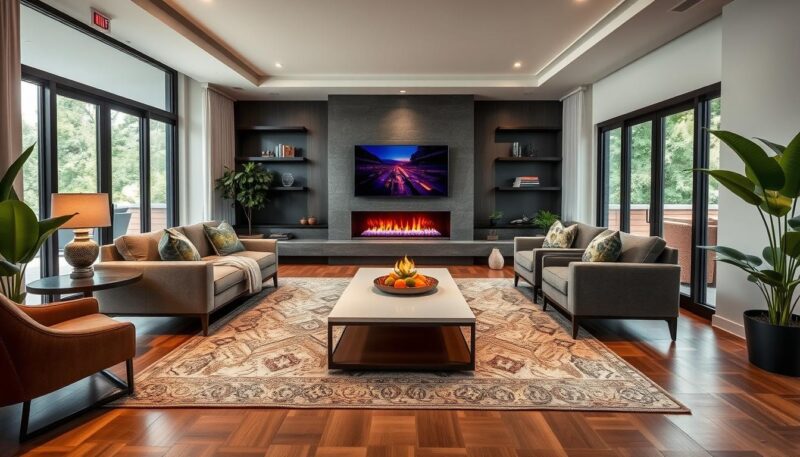
“Furniture layout that facilitates conversation should be chosen for living rooms frequently used for chats with family and friends,” as per Kim Cornelison.
How to Arrange Furniture in a Rectangular Living Room
Utilize Corners and Walls for Additional Seating
When arranging furniture in a rectangular living room, make the most of the corners and walls to create additional seating areas. Place armchairs or a loveseat in the corners to maximize the space and utilize these often-overlooked areas. This strategy not only enhances the room’s functionality but also adds visual interest and a sense of coziness to the overall layout.
Incorporate Rugs to Define Spaces
Strategically placed rugs can be a game-changer when it comes to defining distinct zones within a rectangular living room. Use rugs to delineate the different areas, such as the seating arrangement and the conversation zone. This visual separation helps break up the space and creates a cohesive flow throughout the room, making it feel more intentionally designed.
For instance, position a larger rug under the main seating area to anchor the furniture and establish a clear focal point. Complement this with smaller rugs in other zones, such as a reading nook or a cozy conversation area, to reinforce the room’s functionality and visual balance.
Remember, the size and placement of rugs play a crucial role in enhancing the proportions of a rectangular living room. Choosing the right rug size and positioning it correctly can help create a sense of harmony and prevent the space from feeling overwhelmed or disjointed.
| Furniture Arrangement Technique | Estimated Prevalence in Living Rooms |
|---|---|
| Asymmetrical layouts for narrower living rooms | 20% |
| Seating angled towards the center in larger rectangular living rooms | 10% |
| Floating sofas and armchairs on side walls | 5% |
| Designing different zones for various functions | 15% |
| Open concept living rooms with makeshift barriers | 25% |
| Using credenzas and sofas as room dividers | 7% |
“Correctly scaled furniture is essential to prevent a bowling alley look or a cluttered room.”
Enhance the Room’s Aesthetics and Flow
To create a visually captivating and cohesive design in your rectangular living room, focus on introducing height and vertical elements while playing with a thoughtful mix of colors, patterns, and shapes. These strategies can help break up the linear nature of the space and make it feel more inviting and stylish.
Introduce Height and Vertical Elements
Incorporate tall furniture pieces, such as bookcases or shelving units, to draw the eye upward and add a sense of depth to the room. Statement lighting fixtures, like floor lamps or pendant lights, can also contribute to the vertical interest. Additionally, consider hanging artwork or wall decor at varying heights to create a visually dynamic display.
Play with Colors, Patterns, and Shapes
Experiment with a diverse palette of colors, ranging from bold and vibrant hues to more muted, earthy tones. Incorporate patterns through textiles, wallpapers, or area rugs to add visual texture and break up the linear feel of the space. Juxtapose different shapes, such as rounded coffee tables and angular side chairs, to create a visually engaging and stylish arrangement.
By thoughtfully combining these design elements, you can enhance the overall aesthetics and flow of your rectangular living room, transforming it into a dynamic and visually captivating space.
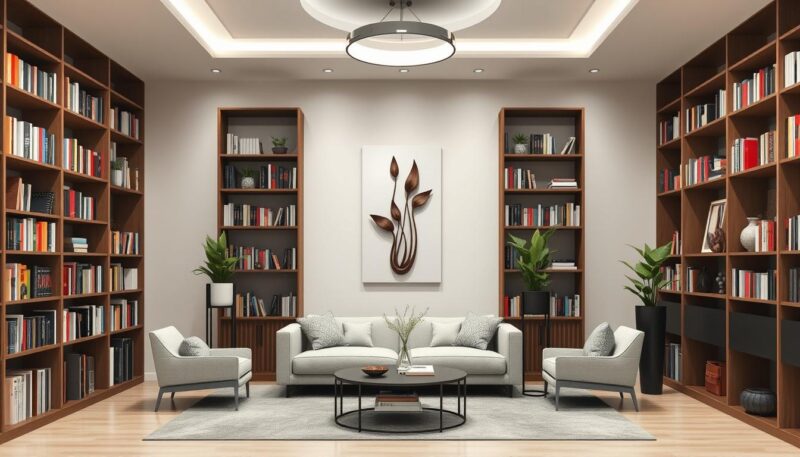
“The key to a successful rectangular living room design is to create a harmonious balance between function and aesthetics. By incorporating height, color, and shape, you can elevate the space and make it feel truly inviting.”
Conclusion
By following the expert design tips and strategies outlined in this article, you can transform your rectangular living room into a functional, stylish, and inviting space. Start by understanding the primary purpose of the room, then strategically arrange the furniture to create defined zones and a balanced layout that maximizes the use of space.
Utilize the corners and walls of your rectangular living room to incorporate additional seating, and don’t forget to incorporate rugs to help define different areas within the space. To enhance the aesthetics and flow of your rectangular living room, play with height, introduce vertical elements, and experiment with colors, patterns, and shapes to create a visually appealing and cohesive design.
With these effective furniture layout ideas and rectangular room design tips, you can create a living space that not only looks great but also promotes smooth traffic flow and a comfortable, inviting atmosphere. By prioritizing functionality and aesthetics, you can maximize the potential of your rectangular living room and enjoy a space that truly reflects your personal style and enhances your everyday living experience.
Source Links
- https://www.thelivinghouse.co.uk/blog-interior-design-tips/how-to-design-your-rectangular-living-room
- https://laurengilberthorpeinteriors.com/layouts-rectangular-sitting-rooms/
- https://venushome.ca/how-to-arrange-furniture-in-rectangular-living-room/?srsltid=AfmBOoo78AJlNmUEyG44yZKeblPi234MaZpCZWOT4b3AlnFMb3y7gvIx
- https://livingroomlay.com/rectangular-living-room-layout-with-tv/
- https://housedesigner.com/arranging-furniture-in-a-rectangular-living-room-layout-tips-and-tricks/
- https://www.bhg.com/rooms/living-room/room-arranging/living-room-furniture-arrangement/
- https://chapinfurniture.com/blogs/living/maximizing-space-practical-tips-for-furniture-layout-in-your-rectangle-living-room?srsltid=AfmBOoogcYVsylRDcXYM0kn3-uNqYLPhb-WFQQen9PJqCyOkfwvcLIAm
- https://www.thespruce.com/rectangle-living-room-layout-8638605
- https://www.settingforfour.com/how-to-arrange-furniture-in-a-rectangular-living-room/
- https://www.clairedaviesinteriors.co.uk/how-to-arrange-living-room-furniture-in-a-rectangular-room
- https://www.ramblingrenovators.ca/2023/04/how-to-arrange-furniture-in-long-narrow-living-room.html
- https://dphome.my/blogs/living-room/how-to-arrange-furniture-in-a-rectangular-living-room
- https://jdelite.decoratingden.com/living-room-furniture-arrangement/
- https://chapinfurniture.com/blogs/living/maximizing-space-practical-tips-for-furniture-layout-in-your-rectangle-living-room?srsltid=AfmBOoox_LJJUpa3DluepZKBZnWLdh0j2blsk6hfc26aUqbQveHv3pKQ
